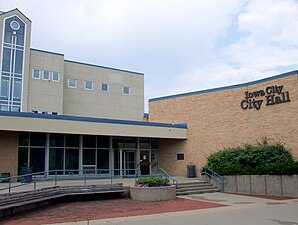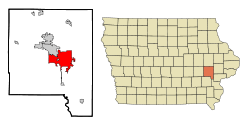Iowa City
| Iowa City | |
|---|---|
 Clinton Street in downtown Iowa City |
|
| Location in Iowa | |
| Basic data | |
| Foundation : | 1839 |
| State : | United States |
| State : | Iowa |
| County : | Johnson County |
| Coordinates : | 41 ° 39 ′ N , 91 ° 32 ′ W |
| Time zone : | Central ( UTC − 6 / −5 ) |
|
Inhabitants : - Metropolitan Area : |
74,398 (as of 2016) 168,828 (as of 2016) |
| Population density : | 1,188.5 inhabitants per km 2 |
| Area : | 63.3 km 2 (approx. 24 mi 2 ) of which 62.6 km 2 (approx. 24 mi 2 ) is land |
| Height : | 204 m |
| Postcodes : | 52242, 52245 |
| Area code : | +1 319 |
| FIPS : | 19-38595 |
| GNIS ID : | 0457827 |
| Website : | www.icgov.org |
| Mayor : | Jim Throgmorton |
 Iowa City City Hall |
|
Iowa City is a city (with the status " City ") and the administrative seat of Johnson County in the US -amerikanischen State Iowa . According to the census in the year 2010 had 67,862 inhabitants Iowa City, the number of which increased by 2016 to around 74,000 (estimate 2016 US Census Bureau ).
Iowa City is the headquarters of the University of Iowa . In the middle of the campus is the historic, former State Capitol of Iowa. A US Army Reserve Center is also located here.
Iowa City is the core city of the same metropolitan area ( "Iowa City metropolitan area").
geography
Iowa City located in East Iowa both sides of the Iowa River , a right tributary of the border Iowa to Illinois forming Mississippi . The intersection of the three states of Iowa, Illinois and Wisconsin is about 135 km northeast of Iowa City. About 3 miles north of the city, the Iowa River is dammed to Coralville Lake .
The geographical coordinates of Iowa City are 41 ° 39'21 "north latitude and 91 ° 31'30" west longitude. The urban area extends over an area of 63.3 km².
Neighboring towns to Iowa City are University Heights (completely enclosed by the western metropolitan area), Solon (11.6 miles north), West Branch (11.4 miles east), West Liberty (28.3 km east-southeast), Hills (8.5 miles south), Kalona (28.7 km southwest), Coralville (on the northwestern city limits), Tiffin (15.8 km west-northwest) and North Liberty (15 km northwest).
The closest major cities are Cedar Rapids (42.8 km northwest), Wisconsin's capital Madison (281 km northeast), the Quad Cities in Iowa and Illinois (87.9 km east), Chicago , Illinois (356 km in the same direction), St. Louis , Missouri (419 km southeast), Kansas City , Missouri (488 km southwest), Iowa's capital Des Moines (183 km west), Nebraska's largest city, Omaha (406 km in the same direction), Rochester , Minnesota (311 km north-northwest) and the Twin Cities of Minnesota (446 km in the same direction).
traffic
Interstate Highway 80 , which runs west to east, runs through the north of the Iowa City metropolitan area. US Highway 218 , which has also been expanded to four lanes, and Iowa Highway 27 , which runs congruently here, run in a north-south direction through the west of the city. US Highway 6 runs in a northwest-southeast direction through downtown Iowa City and intersects Iowa Highway 1 there . All other roads are subordinate country roads, some unpaved roads and inner-city connecting roads.
In the metropolitan area of Iowa City, several railroad lines for the freight traffic of different railroad companies meet.
With the Iowa City Municipal Airport there is a small airfield in the south of the city area. The nearest commercial airport is Cedar Rapids - Eastern Iowa Airport (23 miles northwest).
history
| Population development | |||
|---|---|---|---|
| Census | Residents | ± in% | |
| 1850 | 1250 | - | |
| 1860 | 5214 | 317.1% | |
| 1870 | 5914 | 13.4% | |
| 1880 | 7123 | 20.4% | |
| 1890 | 7016 | -1.5% | |
| 1900 | 7987 | 13.8% | |
| 1910 | 10.091 | 26.3% | |
| 1920 | 11,267 | 11.7% | |
| 1930 | 15,340 | 36.1% | |
| 1940 | 17.182 | 12% | |
| 1950 | 27,212 | 58.4% | |
| 1960 | 33,443 | 22.9% | |
| 1970 | 46,850 | 40.1% | |
| 1980 | 50.508 | 7.8% | |
| 1990 | 59,735 | 18.3% | |
| 2000 | 62,220 | 4.2% | |
| 2010 | 67,862 | 9.1% | |
| 2013 estimate | 71,591 | 5.5% | |
| 1850-2000 2010-2013 | |||
Iowa City was planned to be the new territorial capital following a resolution by the Iowa Territory Parliamentary Assembly in 1839. The Territorial Administration moved from Burlington to Iowa City in 1841 . Five years later, Iowa City also became the capital of the newly formed state of Iowa before moving to Des Moines in 1857.
In 2008, the city was included in the UNESCO Creative Cities Network as the City of Literature .
population
According to the 2010 census , Iowa City had 67,862 people in 27,657 households. The population density was 1084.1 people per square kilometer. Statistically, 2.22 people lived in each of the 27,657 households.
The racial the population was composed of 82.5 percent white, 5.8 percent African American, 0.2 percent Native American, 6.9 percent Asian and 2.1 percent from other ethnic groups; 2.5 percent were descended from two or more races. Hispanic or Latino of any race was 5.3 percent of the population.
14.9 percent of the population were under 18 years old, 76.9 percent were between 18 and 64 and 8.2 percent were 65 years or older. 50.3 percent of the population were female.
The average annual income for a household was 42,220 USD . The per capita income was $ 25,154. 27.9 percent of the population lived below the poverty line.
sons and daughters of the town
- Henry Augustus Pilsbry (1862–1957), biologist, zoologist, malacologist and carciologist
- Mignon Talbot (1869–1950), paleontologist and geologist
- John Y. McCollister (1921-2013), politician
- Lawrence Donald Soens (* 1926), Roman Catholic clergyman, former bishop of Sioux City
- Allan Rex Sandage (1926-2010), astronomer
- Howard C. Berg (* 1934), biophysicist
- Sidney G. Winter (* 1935), economist
- Gail Jefferson (1938-2008), linguist
- Larry Dowd (1940-2006), rockabilly musician
- Diane E. Griffin (* 1940), microbiologist and virologist
- Phyllis Somerville (1943-2020), actress
- Mark Noll (* 1946), evangelical church historian and book author
- Bob Barr (* 1948), lawyer and politician
- Phil Morris (born 1959), actor
- Norm Breyfogle (1960–2018), cartoonist
- Corine Mauch (* 1960), Mayor of Zurich
- Nancy Hogshead (* 1962), swimmer and Olympic champion
- William von Hippel (* 1963), American-Australian social psychologist
- Hill Harper (born 1966), actor
- Michael Schnack (* 1967), conductor, composer and university professor
- Laura Leighton (* 1968), actress
- Jim Butler (* 1971), table tennis player
- Chelsea Cain (* 1972), writer and journalist
- NK Jemisin (* 1972), fantasy author
- Joey Woody (born 1973), athlete
- Tim Dwight (born 1975), football player
- Christian Ahrens (* 1976), rower
- Zach Johnson (born 1976), professional golfer
- Andrew Bentler (* 1978), film editor, film director, film producer and screenwriter
- Sharel Cassity (* 1978), jazz musician
- Michael Mosley (born 1978), actor
- Nate Kaeding (* 1982), football player
- Nate Ruess (* 1982), singer
- Ashley Tesoro (born 1983), actress
- Michael Wacha (born 1991), baseball player
Individual evidence
- ↑ [1] Retrieved January 10, 2019.
- ^ A b American Fact Finder , Retrieved October 1, 2014.
- ↑ Distance information according to Google Maps , accessed on October 1, 2014.
- ↑ AirNav.com - Iowa City Municipal Airport , Accessed on October 1, 2014.
- ^ State Data Center of Iowa , Retrieved October 1, 2014.
- ^ Iowa History Project - Stories of Iowa: How Iowa became a state , Retrieved October 1, 2014.

